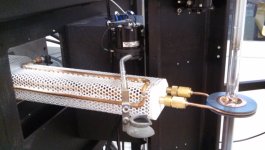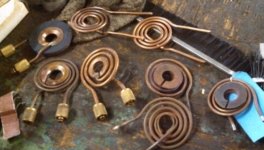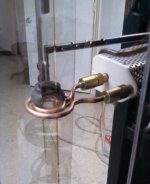Annealing starts by taking the stress between grains out.
Not hard to follow this one, or on micrographs you can see it.
Initially, heating expands/shifts slivers & smaller (Sharp) broken pieces, when the brass cools, there is clearance/stress relief.
This is the benefit most home annealers see, stress relief keeps the brass from cracking g as soon.
The second stage is consolidation/reabsorbing of the dust/slivers from the broken grains.
The slivers/dust are in direct contact with the grain, and are readily reabsorbed.
This is where you CAN go wrong.
Since you must maintain the temp over time for this to happen, home annealer can quite easily overheat the brass and start separating base metals in the alloy.
Full 'Power' heat application is the issue, no reduced power application to maintain temp without increasing the temp...
For the consolidation to happen, it's a better idea to have a very controlled heat source and add TIME for the consolidation to happen. A reduced power ability would solve the time issue without the overheat issues.
The third part of annealing is grain GROWTH.
If the heat is too high (or too long), the grains will absorb each other.
In a micrograph, you are looking at a very specific size sample, relatively just a few microns.
Your micrograph will fill up with a single grain or two, this is a MONO-CHRYSTALINE condition, grains just too big.
When you see a 'Glow', you are well into the area this can happen, at 'Red' or 'Orange', you have ruined the brass.
Like has been printed time & time again, 'Under Annealing' (Lesser Annealing) is preferable by far to ruining the brass! Let the 'Theroy' guys chew on that all they want...
The ONLY way to determine the difference between 'Just Right' & Ruined is a micrograph, which is why I learned to do micrographs, and applied that education to cartridge cases.
A hardness tester won't tell you the difference no matter what any specific annealer manufacturer says.
I tried, it didn't work, had to learn how to mount & prepare a micrograph sample...
The 'Trick' for the home annealer is simply to keep the heat as even as possible, don't overheat the brass, learn when to stop by using some sort of temp indicator. Stay below a 'Glow' and you pretty much get good results.
For the OCD types, buy a microscope and learn to prepare samples, this is destructive testing.
-----
As for rewriting the laws of physics work, or seeing magnetic fields work...
There are cameras that show you the magnetic lay lines, you can actually directly SEE the magnetic field and what it does.
Florida State University has a wonderful magnetics research lab, and they post about everything.
I suggest you have a look at what's happened in the last 3-5 decades since you cracked a textbook (that was wrong in the first place).
Something as simple as laying a sheet of paper on the magnetic field and using magnetic powder to directly SEE the magnetic field also works.
Won't work in this case since the magnetic field flips polarity so fast, but you will get 'Fuzzy' spots where the eddies happen...
When kids got an actual education, every kid laid a sheet of paper on a magnet and sprinkled magnetic powder on that sheet to directly see the magnetic field lay lines.
Nothing 'theoretical' or need static charts/graphs and complicated textbook explanations or EE degrees for it.
If you want to make a sheet that shows you magnetic fields yourself, here is an open source site that shows you how...
http://www.instructables.com/id/Ferrocell-Magnetic-Fields-Viewer/
And as it turns out, there is an 'App' that allows smart phone CCD to directly observe magnetic lay lines in real time...
So, as for 'Rewriting Physics', it's not me, it's technology and people that didn't read the same outdated textbook...
This is a prime example of how these old wives tales get such long lives,
"You don't have *MY* degree, you don't have *MY* textbook (4 or 5 decades old), so you can't POSSABLY know what you are talking about..."
Nothing beats the education you get when you scrape, scratch, claw your way to a result.
Seems the laws of physics didn't read your textbook either!
....
There is a reason we refer to transformer coils by the MAGNETIC CORE types they are...
Stright core, E-core, solid core, laminated core, Ferrite core, etc.
I'll say that again, transformer coils are classified by their MAGNETIC CORE TYPES.
How the CORE shapes & focuses the magnetic field, rounds, flattens, expands, or contracts the MAGNETIC field.
The electrical current means nothing, these coils produce results no matter what the electrical input is...
The shaping of the magnetic field determines the OUTPUT on the other side of the transformer...
EEs choke when you prove this by using exactly the same electrical input, coil winding ratios, but change the core material or shape.
The core simply manipulates the magnetic field, giving it a focus, so the transformer is more or less effective.
The focus/shaping applies to this application as well, even though there isn't a secondary winding since this isn't an electrical conversion/manipulation application...
....
If you want to actually see the change as magnetics went from 'Theroy' to practical use,
Then have a look at a model T car coil, then a round canister coil up until the 70s, then the E-core & bobbin wound coils in modern vehicles.
Everyone that's been under a car hood should be able to relate to that!
It's always interesting to me that EEs have to have the difference between a solid magnetic core & a laminated magnetic core explained to them by a 'Layman' when things go sideways!







